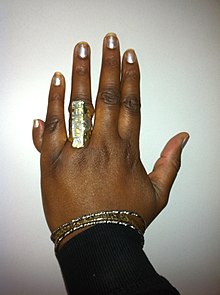
Back كثرة الأصابع Arabic Полидактилия Bulgarian Polidaktilija BS Polidactília Catalan فرەقامکی CKB Polydaktylie Czech Polydactyli Danish Polydaktylie German Polidaktilio Esperanto Polidactilia Spanish
| Polydactyly | |
|---|---|
| Other names | Hyperdactyly |
 | |
| A left Human hand with postaxial polydactyly | |
| Specialty | Medical genetics |
| Usual onset | During pregnancy |
| Duration | Lifelong unless surgically removed |
| Treatment | Surgery in some cases |
| Deaths | None |
Polydactyly or polydactylism (from Greek πολύς (polys) 'many', and δάκτυλος (daktylos) 'finger'),[1] also known as hyperdactyly, is an anomaly in humans and non-human animals resulting in supernumerary fingers and/or toes.[2] Polydactyly is the opposite of oligodactyly (fewer fingers or toes).
- ^ "Polydactyly Etymology". Online Etymology Dictionary. Archived from the original on October 9, 2016. Retrieved February 13, 2016.
- ^ Kaneshiro, Neil K. "Polydactyly – Overview". University of Maryland Medical Center (UMMC). Archived from the original on 30 October 2012. Retrieved 5 January 2013.
© MMXXIII Rich X Search. We shall prevail. All rights reserved. Rich X Search